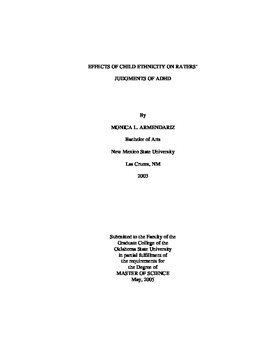| dc.contributor.advisor | Hartung, Cynthia M. | |
| dc.contributor.author | Armendariz, Monica L. | |
| dc.date.accessioned | 2014-04-15T22:23:28Z | |
| dc.date.available | 2014-04-15T22:23:28Z | |
| dc.date.issued | 2005-05-01 | |
| dc.identifier.uri | https://hdl.handle.net/11244/9394 | |
| dc.description.abstract | The purpose of this study was to further investigate differences in behavior ratings between Hispanic and Caucasian children. The current study examined the possibility of a rater bias in judgment of children's behavior. The current study explored whether a child's ethnicity would affect a rater's judgment of a child's behavior. In addition, this study investigated whether an interaction between sex and ethnicity of child would affect a rater's judgment of the child's behavior. Finally, the current study investigated negative halo effects across sex, ethnicity, and Sex Ethnicity. Female undergraduate students participated as raters in the present study. Participant listened to a series of vignettes featuring children engaged in behaviors consistent with different emotional and behavioral disorders and completed rating scales based on the vignettes. To examine possible sex biases, a series of 2 (sex of child) 2 (ethnicity of child) ANOVAs were conducted for target and non-target dimensions. None of the ANOVAs resulted in any significant main effects of sex of child or ethnicity of child in the vignette. In addition, none of the Sex of Child Ethnicity of Child interactions were significant. Results revealed that Caucasian and Hispanic children were not rated differently on target and non-target dimensions depicted in the vignettes. Ethnicity of child did not affect ratings of child behavior in the current study. Furthermore, there were no significant Sex Ethnicity interactions for target and non-target dimensions. These preliminary results imply that rater biases, based on sex, ethnicity, or an interaction, do not account for differential prevalence rates in ADHD. Bi-directional negative halo effects were found for the ADHD-CT vignette and for the ODD vignette. The current study is the first to extend these negative halo effect findings to Hispanic children. Although results from the current study did not provide support for the rater bias hypothesis for explaining the differential prevalence rates of ADHD between Hispanic and Caucasian children, this hypothesis still must not be ruled out due to several limitations in the current study. | |
| dc.format | application/pdf | |
| dc.language | en_US | |
| dc.publisher | Oklahoma State University | |
| dc.rights | Copyright is held by the author who has granted the Oklahoma State University Library the non-exclusive right to share this material in its institutional repository. Contact Digital Library Services at lib-dls@okstate.edu or 405-744-9161 for the permission policy on the use, reproduction or distribution of this material. | |
| dc.title | Effects of Child Ethnicity on Raters' Judgments of ADHD | |
| dc.type | text | |
| dc.contributor.committeeMember | Sullivan Cynthia M. | |
| dc.contributor.committeeMember | Chaney, John M. | |
| osu.filename | Armendariz_okstate_0664M_1322.pdf | |
| osu.college | Arts and Sciences | |
| osu.accesstype | Open Access | |
| dc.description.department | Department of Psychology | |
| dc.type.genre | Thesis | |
